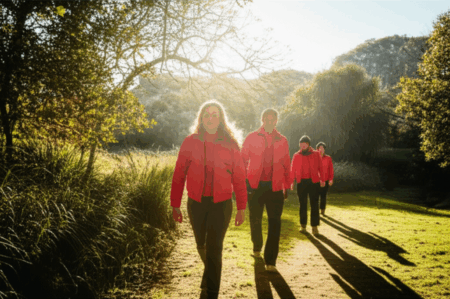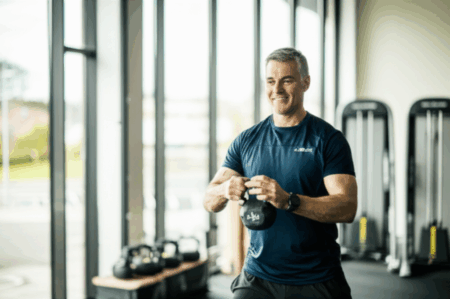As we age, maintaining peak fitness becomes increasingly important, especially for those dedicated to heart health. This article explores a cardiologist’s discovery of a single exercise that transformed their fitness journey at 70, offering insights and guidance for anyone looking to improve their well-being later in life.
Why Fitness Matters, Especially After 70
Maintaining physical fitness as you age offers many benefits, significantly impacting your overall health and quality of life. Some of the key advantages include:
- Reduced Risk of Chronic Diseases: Regular exercise helps to lower the risk of developing chronic conditions such as heart disease, stroke, type 2 diabetes, and certain cancers.
- Improved Cardiovascular Health: Physical activity strengthens the heart muscle, improves circulation, and helps to maintain healthy blood pressure and cholesterol levels.
- Increased Muscle Mass and Strength: Strength training exercises can help to preserve and even increase muscle mass, which naturally declines with age. This is crucial for maintaining strength and mobility.
- Enhanced Bone Density: Weight-bearing exercises, such as walking and strength training, can help to increase bone density and reduce the risk of osteoporosis-related fractures.
- Better Balance and Coordination: Exercises that improve balance and coordination, like Tai Chi and yoga, can help to prevent falls, a common concern among older adults.
- Boosted Mood and Cognitive Function: Physical activity releases endorphins, which have mood-boosting effects and can help to reduce stress, anxiety, and depression. Regular exercise is also linked to improved cognitive function and a reduced risk of dementia.
- Increased Independence and Quality of Life: By maintaining physical fitness, older adults can remain independent and continue to enjoy their favorite activities, enhancing their overall quality of life.
The Exercise That Changed Everything: Strength Training
For this particular cardiologist, the game-changing exercise was strength training. Often overlooked or underestimated, strength training offers unique benefits, especially for individuals over 70. Strength training, also known as resistance training, involves using resistance to contract your muscles, increasing strength and endurance. This can be achieved through:
- Weight Lifting: Using free weights (dumbbells, barbells) or weight machines.
- Bodyweight Exercises: Utilizing your own body weight for resistance (push-ups, squats, lunges).
- Resistance Bands: Employing elastic bands to provide resistance during exercises.
Benefits of Strength Training for Seniors
- Combats Muscle Loss: As we age, we naturally lose muscle mass, a condition known as sarcopenia. Strength training helps preserve and rebuild muscle, improving overall strength and physical function.
- Boosts Metabolism: Muscle tissue burns more calories than fat tissue. Building muscle through strength training can increase your metabolism, aiding in weight management.
- Strengthens Bones: Strength training places stress on your bones, which signals the body to deposit more calcium and increase bone density, reducing the risk of osteoporosis.
- Improves Balance and Coordination: Many strength training exercises improve balance and coordination, reducing the risk of falls.
- Enhances Quality of Life: By increasing strength and endurance, strength training makes everyday activities easier, allowing you to maintain independence and enjoy life to the fullest.
- Reduces Risk of Chronic Diseases: Strength training can help manage and reduce the risk of conditions like arthritis, back pain, heart disease, and diabetes.
- Mental Well-being: Strength training is also associated with improved mood, reduced depression and anxiety, and enhanced cognitive function.
Getting Started with Strength Training
If you’re new to strength training, it’s essential to start slowly and gradually increase the intensity and duration of your workouts. Here are some tips to get started:
- Consult Your Doctor: Before beginning any new exercise program, especially if you have underlying health conditions, consult your doctor. They can help you determine a safe and effective exercise plan.
- Work with a Trainer: Consider working with a certified personal trainer experienced in working with older adults. A trainer can teach you proper form and technique, helping you avoid injuries and maximize results.
- Start with Bodyweight Exercises: Begin with bodyweight exercises like squats, lunges, push-ups (against a wall or on your knees), and planks. These exercises require no equipment and can be easily modified to suit your fitness level.
- Use Light Weights: If you choose to use weights, start with light weights and gradually increase the weight as you get stronger.
- Focus on Proper Form: Proper form is crucial to prevent injuries. Watch videos, work with a trainer, and pay attention to your body to ensure you’re performing exercises correctly.
- Warm-up and Cool-down: Always warm up before each workout with light cardio and stretching, and cool down afterward with gentle stretching.
- Listen to Your Body: Rest when you need to, and don’t push yourself too hard, especially when starting.
Sample Strength Training Routine for Seniors
Here’s a sample strength training routine that you can modify to fit your fitness level:
- Warm-up: 5-10 minutes of light cardio, such as walking, and dynamic stretching, such as arm circles and leg swings.
- Chair Squats: 3 sets of 10-12 repetitions.
- Wall Push-ups: 3 sets of 10-12 repetitions.
- Lunges (using a chair for support if needed): 3 sets of 10-12 repetitions per leg.
- Bicep Curls (with light weights or resistance bands): 3 sets of 10-12 repetitions.
- Overhead Press (with light weights or resistance bands): 3 sets of 10-12 repetitions.
- Calf Raises: 3 sets of 15-20 repetitions.
- Plank (modified on knees if needed): Hold for 30 seconds, 3 repetitions.
- Cool-down: 5-10 minutes of static stretching, holding each stretch for 20-30 seconds.
The Importance of a Balanced Fitness Routine
While strength training played a pivotal role for this cardiologist, it’s important to remember that a balanced fitness routine is key. A comprehensive exercise plan should include:
- Aerobic Exercise: Activities that get your heart pumping, such as brisk walking, jogging, swimming, cycling, or dancing. Aim for at least 150 minutes of moderate-intensity or 75 minutes of vigorous-intensity aerobic exercise per week.
- Strength Training: As discussed above, strength training is essential for maintaining muscle mass, bone density, and overall strength. Aim for at least two non-consecutive days per week.
- Flexibility and Balance Exercises: Exercises that improve flexibility and balance, such as stretching, yoga, and Tai Chi, can help prevent falls and improve overall mobility.
- Mind-Body Activities: Practices like yoga, Pilates, and Tai Chi improve mental clarity, flexibility, and balance, offering a well-rounded approach to fitness.
Sample Balanced Weekly Routine
- Monday: Strength Training (as outlined above)
- Tuesday: Brisk Walking (30-45 minutes)
- Wednesday: Yoga or Pilates (45-60 minutes)
- Thursday: Rest or Light Activity (e.g., gardening, leisurely walk)
- Friday: Strength Training
- Saturday: Swimming or Cycling (30-45 minutes)
- Sunday: Tai Chi or Gentle Stretching
Additional Tips for Staying Fit After 70
- Stay Consistent: Consistency is key to seeing results. Make exercise a regular part of your routine, even if it’s just for a few minutes each day.
- Set Realistic Goals: Set achievable goals to stay motivated. Whether it’s walking for 30 minutes a day, lifting a certain amount of weight, or improving your balance, having goals will help you stay on track.
- Find Activities You Enjoy: Choose activities that you find enjoyable to make exercise feel less like a chore.
- Stay Social: Exercise with friends or in a group to stay motivated and connected.
- Track Your Progress: Use a fitness tracker or journal to monitor your progress and celebrate your achievements.
- Stay Hydrated: Drink plenty of water before, during, and after exercise.
- Get Enough Sleep: Aim for 7-8 hours of sleep per night to allow your body to recover and rebuild.
- Maintain a Healthy Diet: Combine your exercise routine with a balanced diet rich in fruits, vegetables, lean protein, and whole grains.
- Listen to Your Body: Pay attention to your body’s signals and adjust your routine as needed. Don’t hesitate to take rest days when you need them.
- Make it a Lifestyle: Integrate physical activity into your daily life. Take the stairs instead of the elevator, walk during your lunch break, and find other creative ways to stay active.
Conclusion
Discovering the power of strength training was a turning point for this cardiologist, proving that it’s never too late to transform your fitness and well-being. By incorporating strength training into a balanced fitness routine and following these tips, you too can achieve peak fitness at 70 and beyond, enjoying a healthier, more active, and fulfilling life. Remember, consistency, proper guidance, and listening to your body are key to a successful and sustainable fitness journey.







